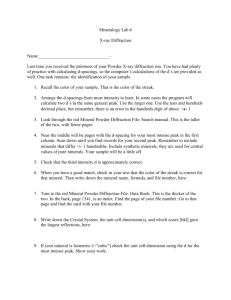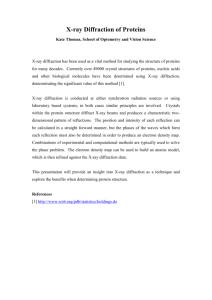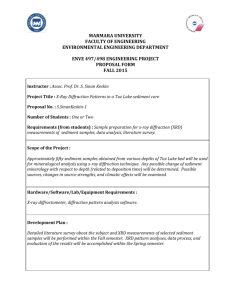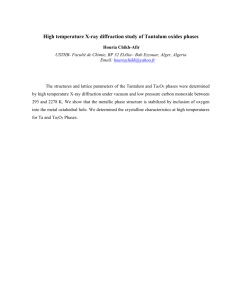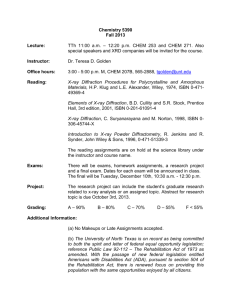XRD-Guanghui
advertisement
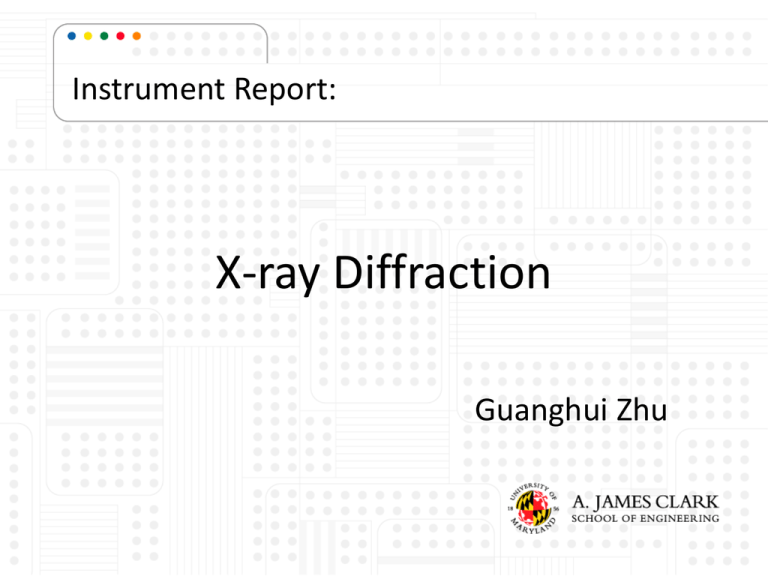
Instrument Report:
X-ray Diffraction
Guanghui Zhu
Contents
•
•
•
•
•
•
Diffraction Mechanism
Construction of the Diffractometer
Applications of XRD
Data Analysis and Explanation
2D XRD
XRD Simulation
Diffraction Mechanism
Crystalline materials are characterized by the orderly
periodic arrangements of atoms.
The (200) planes of atoms in NaCl
The (220) planes of atoms in NaCl
• The unit cell is the basic repeating unit that defines a crystal.
• Parallel planes of atoms intersecting the unit cell are used to define
directions and distances in the crystal.
– These crystallographic planes are identified by Miller indices.
Image: rpp.nashaucheba.ru/docs/index-22828.html
The atoms in a crystal are a periodic array of coherent
scatterers and thus can diffract light.
• Diffraction occurs when each object in a periodic array scatters radiation
coherently, producing concerted constructive interference at specific
angles.
• The electrons in an atom coherently scatter light.
– The electrons interact with the oscillating electric field of the light wave.
• Atoms in a crystal form a periodic array of coherent scatterers.
– The wavelength of X rays are similar to the distance between atoms.
– Diffraction from different planes of atoms produces a diffraction pattern,
which contains information about the atomic arrangement within the crystal
• X Rays are also reflected, scattered incoherently, absorbed, refracted, and
transmitted when they interact with matter.
Bragg’s law
•
q
For parallel planes of atoms, with a space dhkl between the planes, constructive
interference only occurs when Bragg’s law is satisfied.
–
–
–
In our diffractometers, the X-ray wavelength l is fixed.
Consequently, a family of planes produces a diffraction peak only at a specific angle q.
Additionally, the plane normal must be parallel to the diffraction vector
•
•
•
•
q
Plane normal: the direction perpendicular to a plane of atoms
Diffraction vector: the vector that bisects the angle between the incident and diffracted beam
The space between diffracting planes of atoms determines peak positions.
The peak intensity is determined by what atoms are in the diffracting plane.
dhkl dhkl
λ=2dhklsinθ
dhkl
Miller index
• Miller indices form a notation system in crystallography for
planes in crystal (Bravais) lattices.
Image: DeepKling
A single crystal specimen would produce only one family
of peaks in the diffraction pattern.
The (200) planes are parallel
to the (100) planes.
Therefore, they also diffract
for this crystal. Since d200 is
½ d100, they appear at 42
°2q.
2q
At 20.6 °2q, Bragg’s law
fulfilled for the (100) planes,
producing a diffraction peak.
The (110) planes would diffract at 29.3
°2q; however, they are not properly
aligned to produce a diffraction peak (the
perpendicular to those planes does not
bisect the incident and diffracted beams).
Only background is observed.
A polycrystalline sample should contain thousands of
crystallites.
2q
2q
• For every set of planes, there will be a small percentage of
crystallites that are properly oriented to diffract
• Basic assumptions of powder diffraction are that for every
set of planes there is an equal number of crystallites that
will diffract and that there is a statistically relevant number
of crystallites, not just one or two.
2q
Construction of the Diffractometer
Essential Parts
– X-ray Tube: the source of X Rays
– Incident-beam optics: condition the X-ray beam
before it hits the sample
– The goniometer: the platform that holds and
moves the sample, optics, detector, and/or tube
– The sample & sample holder
– Receiving-side optics: condition the X-ray beam
after it has encountered the sample
– Detector: count the number of X Rays scattered by
the sample
Bragg-Brentano geometry
•
•
•
•
•
The incident angle, w, is defined
between the X-ray source and
the sample.
The diffracted angle, 2q, is
defined between the incident
beam and the detector angle.
The incident angle w is always ½
of the detector angle 2q .
In a q:2q instrument (e.g. Rigaku
RU300), the tube is fixed, the
sample rotates at q °/min and
the detector rotates at 2q
°/min.
In a q:q instrument (e.g.
PANalytical X’Pert Pro), the
sample is fixed and the tube
rotates at a rate -q °/min and
the detector rotates at a rate of q
°/min.
Image: http://pd.chem.ucl.ac.uk/pdnn/inst1/optics1.htm
X-radiation
•
•
Sealed X-ray tubes tend to operate at 1.8
to 3 kW.
Rotating anode X-ray tubes produce
much more flux because they operate at
9 to 18 kW.
– A rotating anode spins the anode at 6000
rpm, helping to distribute heat over a
larger area and therefore allowing the
tube to be run at higher power without
melting the target.
•
Both sources generate X rays by striking
the anode target wth an electron beam
from a tungsten filament.
H2O In
H2O Out
Cu
Be
window
ANODE
Be
window
eXRAYS
XRAYS
FILAMENT
(cathode)
metal
glass
(vacuum)
(vacuum)
– The target must be water cooled.
– The target and filament must be
contained in a vacuum.
AC CURRENT
The wavelength of X rays is determined by
the anode of the X-ray source.
•
•
•
Electrons from the filament strike the target anode, producing characteristic
radiation via the photoelectric effect.
The anode material determines the wavelengths of characteristic radiation.
While we would prefer a monochromatic source, the X-ray beam actually
consists of several characteristic wavelengths of X rays.
K
L
M
Spectral Contamination in Diffraction
Patterns
Ka1
Ka1
Ka2
Ka2
Ka1
Ka2
Kb
• The Ka1 & Ka2 doublet will almost always be present
– Very expensive optics can remove the Ka2 line
– Ka1 & Ka2 overlap heavily at low angles and are more separated
at high angles
• W lines form as the tube ages: the W filament contaminates
the target anode and becomes a new X-ray source
• W and Kb lines can be removed with optics
W La1
Wavelengths for X-Radiation
Copper
Anodes
Bearden
(1967)
Holzer et al.
(1997)
Cobalt
Anodes
Bearden
(1967)
Holzer et al.
(1997)
Cu Ka1
1.54056Å
1.540598 Å
Co Ka1
1.788965Å
1.789010 Å
Cu Ka2
1.54439Å
1.544426 Å
Co Ka2
1.792850Å
1.792900 Å
Cu Kb
1.39220Å
1.392250 Å
Co Kb
1.62079Å
1.620830 Å
Cr Ka1
2.28970Å
2.289760 Å
Molybdenum
Anodes
•
•
Chromium
Anodes
Mo Ka1
0.709300Å
0.709319 Å
Mo Ka2
0.713590Å
0.713609 Å
Cr Ka2
2.293606Å
2.293663 Å
Mo Kb
0.632288Å
0.632305 Å
Cr Kb
2.08487Å
2.084920 Å
Often quoted values from Cullity (1956) and Bearden, Rev. Mod. Phys. 39 (1967) are incorrect.
– Values from Bearden (1967) are reprinted in international Tables for X-Ray Crystallography and
most XRD textbooks.
Most recent values are from Hölzer et al. Phys. Rev. A 56 (1997)
The X-ray Shutter--important safety device
on a diffractometer
H2O In
• X-rays exit the tube through X-ray
transparent Be windows.
• X-Ray safety shutters contain the beam so
that you may work in the diffractometer
without being exposed to the X-rays.
• Being aware of the status of the shutters is
the most important factor in working safely
with X rays.
H2O Out
XRAYS
Be
window
Cu
ANODE
Be
window
Primary
Shutter
eXRAYS
Secondary
Shutter
FILAMENT
(cathode)
Solenoid
metal
glass
(vacuum)
(vacuum)
AC CURRENT
SAFETY SHUTTERS
The X-ray divergence
λ=2dhklsinθ
•
X Rays from an X-ray tube are:
– divergent
– contain multiple characteristic wavelengths as well as Bremsstrahlung radiation
•
neither of these conditions suit our ability to use X rays for analysis
– the divergence means that instead of a single incident angle q, the sample is actually
illuminated by photons with a range of incident angles.
– the spectral contamination means that the smaple does not diffract a single wavelength
of radiation, but rather several wavelengths of radiation.
• Consequently, a single set of crystallographic planes will produce several diffraction peaks
instead of one diffraction peak.
•
Optics are used to:
– limit divergence of the X-ray beam
– refocus X rays into parallel paths
– remove unwanted wavelengths
The X-ray divergence slit
• Divergence slits are used to limit the
divergence of the incident X-ray beam.
• The slits block X-rays that have too great a
divergence.
• The size of the divergence slit influences
peak intensity and peak shapes.
• Narrow divergence slits:
– reduce the intensity of the X-ray beam
– reduce the length of the X-ray beam hitting
the sample
– produce sharper peaks
• the instrumental resolution is improved so
that closely spaced peaks can be resolved.
Monochromators
• Diffraction from a crystal monochromator can be used to select one
wavelength of radiation and provide energy discrimination.
• An incident-beam monochromator might be used to select only Ka1
radiation for the tube source.
• A diffracted-beam monochromator may be used to remove fluoresced
photons, Kb, or W-contimination photons from reaching the detector.
– Without the RSM slit, the monochromator removes ~75% of unwanted
wavelengths of radiation.
– When the RSM slit is used, over 99% of the unwanted wavelengths of
radiation can be removed from the beam.
Detectors
• Point detectors
– observe one point of space at a time
• slow, but compatible with most/all optics
– scintillation and gas proportional detectors count all photons, within an
energy window, that hit them
– Si(Li) detectors can electronically analyze or filter wavelengths
• Position sensitive detectors (PSD)
– linear PSDs observe all photons scattered along a line from 2 to 10° long
– 2D area detectors observe all photons scattered along a conic section
– gas proportional (gas on wire; microgap anodes)
• limited resolution, issues with deadtime and saturation
– CCD
• limited in size, expensive
– solid state real-time multiple semiconductor strips
• high speed with high resolution, robust
Applications of XRD
Typical 1D Diffraction
Intensity (a.u.)
[HighRes_run113_12hr scan.xml] run113 mono-Y2O3 OVD
59
20
30
40
50
60
60
70
61
80
2q (deg.)
62
63
90
64
100
65
110
66
120
67
130
68
You can use XRD to determine
• Phase Identification
– Quantitative Phase Analysis: determine the relative amounts of phases in a
mixture by referencing the relative peak intensities
• Unit cell lattice parameters and Bravais lattice symmetry
– Index peak positions
– Lattice parameters can vary as a function of, and therefore give you
information about, alloying, doping, solid solutions, strains, etc.
• Residual Stress (macrostrain)
• Crystal Structure
– By Rietveld refinement of the entire diffraction pattern
• Epitaxy/Texture/Orientation
• Crystallite Size and Microstrain
– Indicated by peak broadening
– Other defects (stacking faults, etc.) can be measured by analysis of peak
shapes and peak width
• In-situ XRD
Phase Identification
• The diffraction pattern for every phase is as unique as your fingerprint
– Phases with the same chemical composition can have drastically different
diffraction patterns.
– Use the position and relative intensity of a series of peaks to match
experimental data to the reference patterns in the database
Phase Identification
• The PDF (Powder Diffraction File) contains over 200,000 diffraction patterns.
• Modern computer programs can help you determine what phases are
present in your sample by quickly comparing your diffraction data to all of
the patterns in the database.
• The PDF card for an entry contains a lot of useful information, including
literature references.
•
•
•
•
With high quality data, you can determine how
much of each phase is present
– must meet the constant volume
assumption (see later slides)
The ratio of peak intensities varies linearly as a
function of weight fractions for any two phases
in a mixture
– need to know the constant of
proportionality
RIR method is fast and gives semi-quantitative
results
Whole pattern fitting/Rietveld refinement is a
more accurate but more complicated analysis
I(phase a)/I(phase b) ..
Quantitative Phase Analysis
60
50
40
30
20
10
0
0
0.2
0.4
0.6
X(phase a)/X(phase b)
0.8
1
Unit Cell Lattice Parameter Refinement
• By accurately measuring peak positions over a long range of
2theta, you can determine the unit cell lattice parameters of
the phases in your sample
– alloying, substitution doping, temperature and pressure, etc. can
create changes in lattice parameters that you may want to quantify
– use many peaks over a long range of 2theta so that you can identify
and correct for systematic errors such as specimen displacement and
zero shift
– measure peak positions with a peak search algorithm or profile fitting
• profile fitting is more accurate but more time consuming
– then numerically refine the lattice parameters
Residual Stress
Epitaxy/Texture/Orientation
• Preferred orientation of crystallites can create a systematic
variation in diffraction peak intensities
– can qualitatively analyze using a 1D diffraction pattern
– a pole figure maps the intensity of a single peak as a function of tilt
and rotation of the sample
• this can be used to quantify the texture
10.0
00-004-0784> Gold - Au
(111)
Intensity(Counts)
8.0
(311)
(200)
6.0
(220)
4.0
(222)
2.0
(400)
x10
3
40
50
60
70
Two-Theta (deg)
80
90
100
Crystallite Size and Microstrain
•
Crystallites smaller than ~120nm create broadening of diffraction peaks
– this peak broadening can be used to quantify the average crystallite size of
nanoparticles using the Scherrer equation
– must know the contribution of peak width from the instrument by using a calibration
curve
Microstrain may also create peak broadening
– analyzing the peak widths over a long range of 2theta using a Williamson-Hull plot
can let you separate microstrain and crystallite size
00-043-1002> Cerianite- - CeO2
Kl
B2q
L cos q
Intensity (a.u.)
•
23 24 25 26 27 28 29 30 31 32 33 34 35 36 37 38 39 40 41
2q (deg.)
Data
Diffraction patterns are best reported using dhkl and
relative intensity rather than 2q and absolute intensity.
• The peak position as 2q depends on instrumental characteristics such as
wavelength.
– The peak position as dhkl is an intrinsic, instrument-independent, material
property.
• Bragg’s Law is used to convert observed 2q positions to dhkl.
• The absolute intensity, i.e. the number of X rays observed in a given peak,
can vary due to instrumental and experimental parameters.
– The relative intensities of the diffraction peaks should be instrument
independent.
• To calculate relative intensity, divide the absolute intensity of every peak by the
absolute intensity of the most intense peak, and then convert to a percentage. The
most intense peak of a phase is therefore always called the “100% peak”.
– Peak areas are much more reliable than peak heights as a measure of intensity.
Powder diffraction data consists of a record of photon
intensity versus detector angle 2q.
•
Diffraction data can be reduced to a list of peak positions and intensities
– Each dhkl corresponds to a family of atomic planes {hkl}
– individual planes cannot be resolved- this is a limitation of powder diffraction versus
single crystal diffraction
Raw Data
Reduced dI list
Position
[°2q]
Intensity
[cts]
25.2000
372.0000
25.2400
460.0000
25.2800
576.0000
25.3200
752.0000
25.3600
1088.0000
25.4000
1488.0000
25.4400
1892.0000
25.4800
2104.0000
25.5200
1720.0000
25.5600
1216.0000
25.6000
732.0000
25.6400
456.0000
25.6800
380.0000
25.7200
328.0000
hkl
dhkl (Å)
Relative
Intensity
(%)
{012} 3.4935
49.8
{104} 2.5583
85.8
{110} 2.3852
36.1
{006} 2.1701
1.9
{113} 2.0903
100.0
{202} 1.9680
1.4
Sample Preparation
Preparing a powder specimen
• An ideal powder sample should have many crystallites in random
orientations
– the distribution of orientations should be smooth and equally distributed
amongst all orientations
• If the crystallites in a sample are very large, there will not be a smooth
distribution of crystal orientations. You will not get a powder average
diffraction pattern.
– crystallites should be <10mm in size to get good powder statistics
• Large crystallite sizes and non-random crystallite orientations both lead to
peak intensity variation
– the measured diffraction pattern will not agree with that expected from an
ideal powder
– the measured diffraction pattern will not agree with reference patterns in the
Powder Diffraction File (PDF) database
Preferred orientation
• If the crystallites in a powder sample have plate or needle like
shapes it can be very difficult to get them to adopt random
orientations
– top-loading, where you press the powder into a holder, can cause
problems with preferred orientation
• In samples such as metal sheets or wires there is almost
always preferred orientation due to the manufacturing
process
• For samples with systematic orientation, XRD can be used to
quantify the texture in the specimen
Important characteristics of samples for XRPD
• a flat plate sample for XRPD should have a smooth flat surface
– if the surface is not smooth and flat, X-ray absorption may reduce the
intensity of low angle peaks
– parallel-beam optics can be used to analyze samples with odd shapes
or rought surfaces
•
•
•
•
Densely packed
Randomly oriented grains/crystallites
Grain size less than 10 microns
‘Infinitely’ thick
Way to prepare a powder sample
• Top-loading a bulk powder into a well
– deposit powder in a shallow well of a sample holder. Use a
slightly rough flat surface to press down on the powder,
packing it into the well.
• using a slightly rough surface to pack the powder can help
minimize preferred orientation
• mixing the sample with a filler such as flour or glass powder may
also help minimize preferred orientation
• powder may need to be mixed with a binder to prevent it from
falling out of the sample holder
– alternatively, the well of the sample holder can be coated with a thin
layer of vaseline
2D XRD
Introduction
• Two-dimensional x-ray diffraction (XRD2) refers to x-ray diffraction
applications with two dimensional (2D) detector and corresponding data
reduction and analysis.
• In addition to the 2D detector technology, it involves 2D image processing
and 2D diffraction pattern manipulation and interpretation.
Image: Bruker Analytical X-ray Systems
Components
Two-dimensional detector, x-ray source, x-ray
optics, sample positioning stage, sample alignment
and monitoring device as well as corresponding
computer control and data reduction and analysis
software
Image: Bruker Analytical X-ray Systems
XRD vs. XRD2
Image: Bruker Analytical X-ray Systems
2D Diffraction image
Polycrystalline thin film on a
single crystal substrate
Mixture of fine and coarse grains
in a metallic alloy
Conventional linear diffraction patterns would miss
information about single crystal or coarse grained materials
Sample Rotation
Image: Bruker Analytical X-ray Systems
Applications
•
•
•
•
Phase identification (Phase ID) can be done by integration over a selected range
of 2θ and γ. The integrated data gives better intensity and statistics for phase ID
and quantitative analysis, especially for those samples with texture, large grain size,
or small quantity.
Texture measurement is extremely fast. An XRD2 system collects texture data and
background values simultaneously for multiple poles and multiple directions. Due
to the high measurement speed, Pole figure can be measured at very fine steps for
sharp textures.
Stress can be measured using the 2D fundamental equation, which gives the direct
relationship between the stress tensor and the diffraction cone distortion. Since
the whole or a part of the Debye ring is used for stress calculation, it can measure
stress with high sensitivity, high speed and high accuracy. It is very suitable for
large grain and textured samples.
Percent crystallinity can be measured faster and more accurately with the data
analysis over the 2D pattern, especially for samples with anisotropic distribution of
crystalline orientation.
Applications(cont’d)
•
•
•
Small angle x-ray scattering (SAXS) data can be collected at high speed.
Anisotropic features from specimens, such as polymers, fibrous materials, single
crystals and bio-materials, can be analyzed and displayed in two-dimension. Desmearing correction is not necessary due to the collimated point x-ray beam. Since
one exposure takes all the SAXS information, it is easy to scan over the sample to
map the structure information.
Microdiffraction data is collected with speed and accuracy. The 2D detector
captures whole or a large portion of the diffraction rings, so spotty, textured, or
weak diffraction data can be integrated over the selected diffraction rings.
Thin film samples with a mixture of single crystal, random polycrystalline layers
and highly textured layers can be measured with all the features appearing
simultaneously in 2D frames.
XRD Simulation
Bragg’s Law
dhkl
Scattering Amplitude-Structure Factor F
Scattering Amplitude-Scattering Factor f
Peak Width
𝐵 2𝜃 =
𝐾𝜆
𝐿𝑐𝑜𝑠𝜃
• Peak Width B(2q) varies inversely with crystallite size
• The constant of proportionality, K (the Scherrer constant) depends on
the how the width is determined, the shape of the crystal, and the size
distribution
– The most common values for K are 0.94 (for FWHM of spherical crystals
with cubic symmetry), 0.89 (for integral breadth of spherical crystals with
cubic symmetry, and 1 (because 0.94 and 0.89 both round up to 1).
– K actually varies from 0.62 to 2.08
– For an excellent discussion of K,
JI Langford and AJC Wilson, “Scherrer after sixty years: A survey and some new
results in the determination of crystallite size,” J. Appl. Cryst. 11 (1978) p102-113.
Diffraction Pattern
Where to Get Crystal Structures
Software for Simulation
PANalytical X’Pert HighScore Plus
• With the crystal structure information, we can build a
crystal in HSP
• Then we can simulate the ideal X-Ray powder diffraction
pattern in HSP
• The pattern simulation parameters can be changed in
Program Settings
• We can change parameters for the crystal structure and
observe how they change the diffraction pattern
Note
• These simulations do not necessarily represent the data that
your diffractometer will produce
• There are more factors that contribute to the diffraction
pattern that you collect with an instrument
• Some of these factors are calculated from fundamental
equations
– The simulations that we have been executing already account for
multiplicity, for Ka2 radiation, and for the Lorentz polarization factor
• Some of these factors are approximated using empirical
formulas
– The simulations that we have been executing already account for the
peak width due to divergence, mosaicity, resolution of the
diffractometer
Supplementation
XRD @ UMD
• http://www2.chem.umd.edu/facility/xray
• Chemical Crystallography lab
– Bruker Apex2
– Bruker Smart1000
• Materials Characterization lab
– Bruker C2 Discover
– Bruker D8 Advance
• Protein Crystallography lab
– Bruker Proteum X8 (coming soon)
Recommend Readings
• Elements Of X Ray Diffraction, B.D.Cullity
• Fundamentals of Powder Diffraction and Structural
Characterization of Materials, Second Edition, Vitalij K.
Pecharsky and Peter Y. Zavalij
• Collection of Simulated XRD Powder Patterns for Zeolites,
M.M.J. Treacy and J.B. Higgins, IZA
Useful Software
•
•
•
•
•
•
MDI Jade
PANalytical HighScore Plus
PANalytical Stress
PANalytical Texture
PANalytical Reflectivity
Bruker Multex Area
Thank You!
